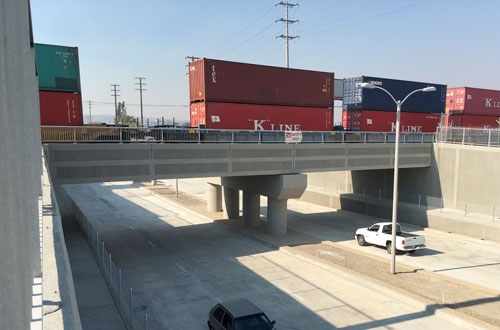ACE Construction Authority cuts ribbon on Nogales grade separation
Written by Jenifer Nunez, assistant editor
Federal, state and local officials officially opened a six-lane roadway underpass at a once-hazardous and congested railroad crossing at Nogales Street north of the Pomona (60) Freeway in California.
Located on the transcontinental Alameda Corridor-East (ACE) corridor, the Nogales Street crossing was a top priority for grade separation. During the decade before construction began in March 2014, 10 crossing collisions were recorded. The roadway carried more than 40,000 vehicles a day and was blocked by 49 trains a day, a number that is projected to increase to 91 trains per day by 2025.
“The Nogales Street project eliminates the potential for train-vehicle collisions, delays for emergency responders, locomotive horn noise and reduces emissions,” Montebello Councilman Jack Hadjinian, chair of the ACE Construction Authority Board of Directors, said during the dedication ceremony. “We appreciate the support of our partner agencies for providing the funds needed to complete this important project.”
The $118.2-million project was completed using funding from the California state transportation bond, the Los Angeles County Metropolitan Transportation Authority, the federal government and contributions from the city of Industry and Union Pacific.
“The ACE grade separations to address the community impacts of goods movement along transcontinental freight rail lines merit strong federal support,” said U.S. Rep. Grace Napolitano (D-Ca), California’s ranking member on the Transportation and Infrastructure Committee of the U.S. House of Representatives. “That is why I successfully advocated for the establishment of new national freight programs to provide $2 billion a year to support projects like the ACE grade separations and have urged the U.S. Department of Transportation to award discretionary freight grant funds to ACE.”
The ACE Corridor carries about 60 percent of the containers that arrive at the San Pedro Bay ports – the busiest in the nation, handling more than 40 percent of the nation’s container trade. In doing so, the corridor plays a critical role in the economic vitality and quality of life for Southern California. Goods movement and related industries represent one-third of all jobs and economic activity in the region.





